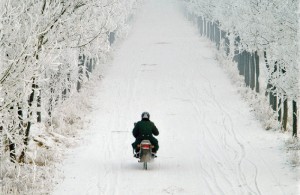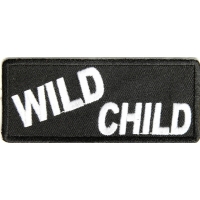 Riding a motorcycle may seem impractical during certain parts of the year or if you live in certain areas. Unlike a car, there is no protection from the elements, so it can be quite chilly or incredibly warm to ride your motorcycle in extreme weather. There are also dangers such as slick pavement that you have to worry about. However, just because it might be uncomfortable does not mean die-hard motorcycle riders aren't going to get on their bikes and ride! Before you head outdoors, make sure you know what the weather is going to be like and know how to handle the different climates.
Riding a motorcycle may seem impractical during certain parts of the year or if you live in certain areas. Unlike a car, there is no protection from the elements, so it can be quite chilly or incredibly warm to ride your motorcycle in extreme weather. There are also dangers such as slick pavement that you have to worry about. However, just because it might be uncomfortable does not mean die-hard motorcycle riders aren't going to get on their bikes and ride! Before you head outdoors, make sure you know what the weather is going to be like and know how to handle the different climates.
Sunny, Warm Weather
This is, obviously, the best type of weather or climate to ride in. It's nice out, the roads are clear, and it's warm but not too hot. You might even have a nice breeze to help cool you do when you're stopped at a light. However, there is one thing to keep in mind here: it may be uncomfortable to wear a jacket or long pants during these warm days. If you crash, you're going to get hurt. You may want to look for lightweight clothing that offers some protection to wear when riding in these areas. Also, even though it's hot, you may still want to put on your full motorcycle helmet (especially if it's the law in your state).
Hot Weather
In some areas, temperatures can easily reach triple digits in the middle of summer. Riding during these times might seem like a good idea, but it's actually pretty miserable. The sun is sure to beat down on you, and even though you'll want to wear relatively light clothing, remember again that a crash is going to hurt. Your awesome biker jacket might be too hot to wear, but at least find a light but long-sleeved shirt to help protect your arms. Something is better than nothing! You'll also definitely want some sunblock if you're going to be riding for more than a few minutes. Otherwise, you may end up very sunburnt. You might want to keep an emergency bottle of sunblock in your saddlebags during the summer.
Another thing to remember during hot weather is to try to park your bike in the shade. Otherwise, the metal can get very hot. Touching that hot metal with your bare hands may even burn if the bike has been in the sun for several hours. If you can't find a shady spot to park in, keep a small tarp or blanket to drape over your bike.
Don't forget to wear your helmet or at least a hat during the sunny months to keep the top of your head from burning!
Cold Weather
Most bikers actually like riding in the cold. They get to wear their biker jacket with all of the different patches on it along with the rest of their riding gear. The heat from the bike's engine helps keep the chill away, too. There's nothing really bad about riding in the cold as long as you've bundled up. In fact, the only real danger is when the weather turns rotten and it starts to snow or ice builds up on the road. You may want to stash a warm cap, scarf, and extra pair of gloves in the saddlebags during the winter just in case you forget yours.
Rainy Weather
Riding in rainy weather can present a few different problems for the biker. The first is that the roads are going to be slick, so you'll want to take a few extra precautions. Drive a little more slowly, and don't slam on your brakes at the last minute. Also, watch for puddles. If the vehicle in front of you hits one, it may splash up all over you and your bike. Because of that, you may want to keep a little extra distance between you and other vehicles. Also, be ready to put your foot down in a puddle or even running water. If you aren't wearing waterproof boots, you're probably going to get a lot of water in your shoe. Visibility may also be an issue if it is pouring down, and other drivers may not always be able to see motorcycles. You may want to pull over somewhere until the worst of the rain passes by.
The other issue with rain is that you're going to get very wet. If you know it might rain, you can dress appropriately, but sometimes storms come up out of nowhere. Because of that, you might want to keep a raincoat or poncho in your saddlebags. This is especially true if you're going on a multi-day ride.
Snow and Sleet
Snow is similar to rain in that you'll want to drive a little more slowly and make sure you have plenty of space to brake. It's not necessarily going to be slick, but it can start to accumulate. A bad snowstorm or sleet storm can also greatly reduce visibility. If you aren't certain you can be seen on the road, you may want to seek shelter until it blows over. Also keep in mind that it's likely to be very cold out, so try to find somewhere warm to wait out the storm.
Ice
This is probably the absolute worst weather to ever have to ride in. When the roads have iced over, they are incredibly slick, and accidents happen frequently. One thing all motorists have to watch out for is black ice. It's almost impossible to see, so you have to drive very slowly and test your traction often. Most experts strongly recommend not driving on ice at all, especially on a motorcycle, because it is so dangerous. If you do have to get out, be very careful. Keep a good distance between your bike and all other vehicles on the road. Be prepared to put your foot down often to keep your bike under control.
Drive Safely!
Remember to always drive safely, especially in weather you've never experienced before. Motorcycles handle differently than other vehicles, so until you've ridden your bike in a certain type of weather, approach that ride with a little more caution than usual.


